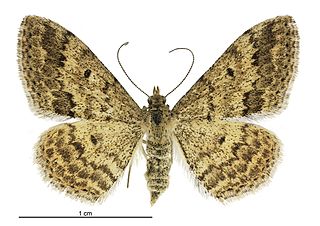
Scopula rubraria is a species of moth of the family Geometridae. It is native to both New Zealand and Australia.

Orocrambus flexuosellus is a species of moth in the family Crambidae. It was first described by Edward Doubleday in 1843. O. flexuosellus is endemic to New Zealand. It has been recorded from the North Island, South Island and the Stewart Islands. The species' habitat consists of lowland to alpine grasslands.
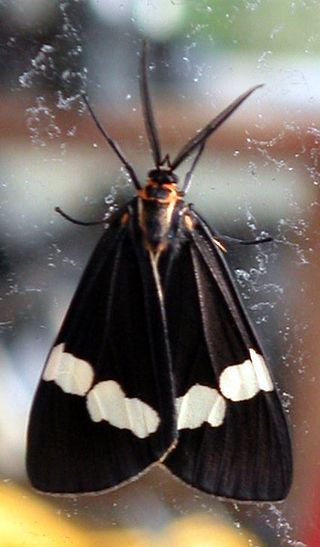
Nyctemera annulata, the magpie moth, is a moth of the family Erebidae. The species was first described by Jean Baptiste Boisduval in 1832. It is endemic to New Zealand and found in all parts of the country.

Stenotus binotatus is a species of plant bug, originally from Europe, but now also established across North America and New Zealand. It is 6–7 mm (0.24–0.28 in) long, yellowish, with darker markings on the pronotum and forewings. It feeds on various grasses, and can be a pest of crops such as wheat.

Wiseana copularis is a species of moth belonging to the family Hepialidae. It is endemic to New Zealand. This moth is one of several very similar looking species within the genus Wiseana and this group are collectively referred to as "Porina" moths. In its larvae form this species consumes pasture grasses and, if numerous, is regarded as a pest by New Zealand farmers reliant on good quality pasture for their stock.
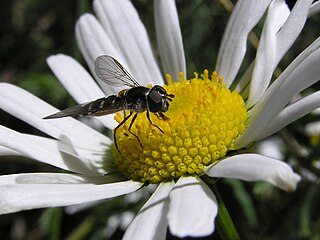
Melangyna novaezelandiae is a hoverfly endemic to New Zealand. It is a generalized pollinator of a large range of plants that are both native and exotic to the New Zealand flora. M. novaezelandiae is widespread throughout New Zealand, including in agricultural environments. The larvae of this species feeds on other arthropods and may have uses as a biocontrol agent.
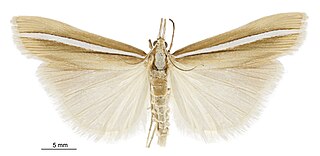
Orocrambus crenaeus is a moth in the family Crambidae. It was described by Edward Meyrick in 1885. It is endemic to New Zealand, where it is known from the South Island. The habitat consists of alpine grasslands.

Orocrambus cyclopicus is a moth in the family Crambidae. It was described by Edward Meyrick in 1883. In 1975 David E. Gaskin wrongly synonymised Crambus sophistes with Orocrambus cyclopicus.

Orocrambus enchophorus is a moth in the family Crambidae. It was described by Edward Meyrick in 1885. It is endemic to New Zealand. It has been recorded from the South Island and North Island. The lives in lowland to alpine grassland habitat.
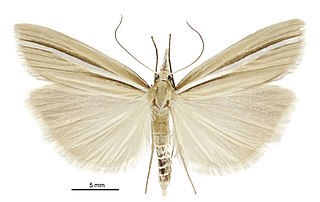
Orocrambus simplex is a moth in the family Crambidae. It was described by Arthur Gardiner Butler in 1877. It is endemic to New Zealand, where it has been recorded in Westland, Nelson Province, the central part of the North Island and the coastal area of southern Hawkes Bay. The habitat where this species lives consists of tussock grasslands.

Orocrambus vittellus is a moth in the family Crambidae. It was described by Henry Doubleday in 1843. It is endemic to New Zealand. This species has been recorded in the North and South Islands, as well as Stewart Island. It prefers a habitat that consists of grasslands.
Edward Edinborough Chamberlain was a New Zealand plant pathologist.

George Darvel Hill was a New Zealand agronomist, naval reservist, and a justice of the peace and unionist.
Margot Bernice Forde was a New Zealand botanist, curator, and taxonomist.

Bromus sitchenis, the Alaska brome, is a perennial grass native to the North Pacific coast of North America, in woods and banks from Alaska to Oregon. It can grow up to 1.8 m tall, but is often shorter. Leaf blades are elongate, 7–12 mm wide, and as much as 35 cm long. Spikelets 2.5 to 3.5 cm long with between 6 and 12 flowers, awn is 5 to 10 mm long.

Naupactus leucoloma is a species of broad-nosed weevil in the beetle family Curculionidae.
Brenda Mabel May was a New Zealand speleological entomologist known for her contributions to the understanding of weevil larvae biology. Between 1956 and 1980, she worked in the Entomology Division of the Department of Scientific and Industrial Research (DSIR). Afterwards, she became a research associate at Landcare Research, where she completed a systematic overview of New Zealand Curculionoidea, published in 1993. In 1998, May was elected as a Fellow of the Entomological Society of New Zealand in recognition of her contributions.

Poa colensoi, the blue tussock, is a species of cool-season grass in the family Poaceae, endemic to New Zealand. It is considered the native grass species with the highest potential for use in high altitude livestock grazing systems, as it has good palatibility and above average regrowth rates.

Sidnia kinbergi, also known by its common name Australian crop mirid is a species from the genus Sidnia.
Rebecca Edith Hickson is a New Zealand academic scientist, and is a full professor at Massey University, specialising in improving the production of beef from cast-off dairy calves.















